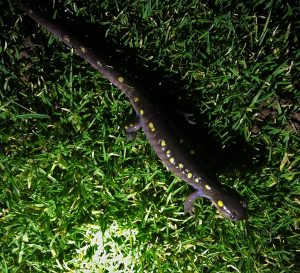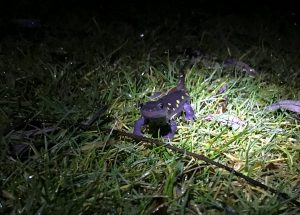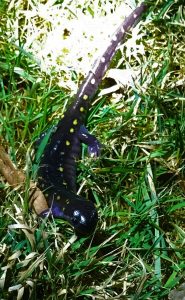The spotted salamander is one of the most prominent salamanders found in the woods and forests around Ithaca. A few weeks ago, back when Ithaca briefly decided winter was ending, and it was beginning to feel more like spring, they began their annual migration. I was able to bring a handful of veterinary students with me to witness this event, and many seemed interested in learning more about these little guys and their lifecycle. I hope to address some of the more common questions here.
Spotted what?
The spotted salamander is a small (6 to 9-inch-long) salamander most notable for its blueish-black coloration, with two rows of bright yellow spots running down either side of its back from head to tail. It is commonly found in the Eastern United States and Canada. It belongs to a group of salamanders known as mole salamanders (genus Ambystoma), and, as such, is adapted to living most of its life on land. Its most significant adaptation is the presence of true lungs in the adult animal.
Why are they migrating?
Migration is a normal part of a spotted salamander’s life! Like all amphibians, once they hatch from their eggs, they begin their lives as aquatic and free-swimming larvae. The larvae will grow into juvenile salamanders capable of living on land within 2-4 months of hatching. However, to start out in water, their eggs must be laid in the water; this is where the migration comes in. Adult salamanders will often return to the pond in which they were born to find, and mate with, other salamanders. They will then lay their eggs in large jelly-like clumps that can be found underwater in these ponds. After a couple of months, the eggs will hatch, starting the cycle over again.
How often does this happen?
Spotted salamanders are triggered by the warming weather and gentle rains that come with the end of winter and beginning of spring. When it is too cold, their metabolism is simply not active enough to allow them to make the trip, and a prolonged journey in dry weather can be damaging to their skin. Additionally, most salamanders breed in vernal ponds, which can dry up later in the season. As the salamander’s future offspring need to be fully developed and able to survive on land by the time the pools dry up, there is significant pressure on these animals to get out and migrate as soon as possible. As a result, you typically will only see one migration a year, consisting of all the salamanders living in a specific area. It is important to note that spotted salamanders will also migrate back from their vernal ponds after breeding, but this event is much less predictable, and much less spectacular, as they will move in several waves.
Where do they live normally?
When not breeding or migrating, spotted salamanders adopt a lifecycle similar to all other mole salamanders. They live in forests, under leaf litter and debris where it remains moist most of the time. They will also inhabit burrows to stay cool and moist. While not big diggers themselves, they will gladly occupy the burrows of other animals, if available. This tends to be not a big problem, as it allows them to hide from most larger predators, and smaller predators will be dissuaded by the toxins found in the salamander’s skin. In the event they do encounter a predator, salamanders have an unprecedented ability to regenerate their body. They have been noted to regrow their tails, limbs, and even parts of their brain, although this can take a massive amount of energy.
How do they survive the winter?
With the onset of winter, spotted salamanders will typically seek out deep burrows, hopefully ones that are under the frost line. When cold weather comes, these animals will enter a state known as brumation. Brumation is similar to hibernation in mammals, such as seen in black bears. However, hibernation is a state caused by prolonged unconsciousness, whereas brumation is a state were prolonged unconsciousness is caused by a lack of metabolism. Bears sleep to hibernate; amphibians are asleep because of brumation. If the weather warms up, as tends to happen periodically, brumating animals will become briefly active, whereas hibernating animals will stay asleep. Additionally, when the seasons change many amphibians have the ability to rapidly mobilize glycogen into glucose, thus raising the amount of glucose present in their blood and tissues. This effectively raises the freezing point of their tissues, similar in effect to putting antifreeze in your car. This also means that, upon defrosting, these animals will rapidly have a source of glucose to keep their cells alive, even if their circulatory system hasn’t fully recovered yet.
How do you know when the migration is occurring?
I got this question a lot. What it breaks down to is knowing the natural biology of the spotted salamander that I have previously discussed. Upon the end of winter, usually in March or April, you need to wait for the right conditions. On particularly rainy days, where the average temperature is at least 45 degrees Fahrenheit, you should have a high suspicion that these animals will be on the move. I simply waited for the right conditions, and went to check the fields on appropriate nights. The migrations start around 8:00 pm, with peak movements occurring between 9-11 pm, although it may continue throughout the night. If you see salamanders as early as 8:00 pm, you can guarantee there will be more on the move shortly.
Do be careful if you go out though. Salamanders and other amphibians have not exactly adapted well to human encroachment of their environment. While this weather means there will be lots of salamanders on the fields, there will also be salamanders, frogs, and toads out enjoying the wonderful weather on the roads. The day after every warm, rainy night, you will invariably find squashed amphibians on roads that are near ponds. If you live near such a pond (the high-pitched chirping of thousands of spring peepers will tell you if you do), please be careful on the roads, and keep a lookout for our tiny “cold-blooded” friends.
ABOUT THE AUTHOR:
Jonah Marion is a second year Cornell veterinary student with a primary interest in reptile and companion exotic animal medicine.



